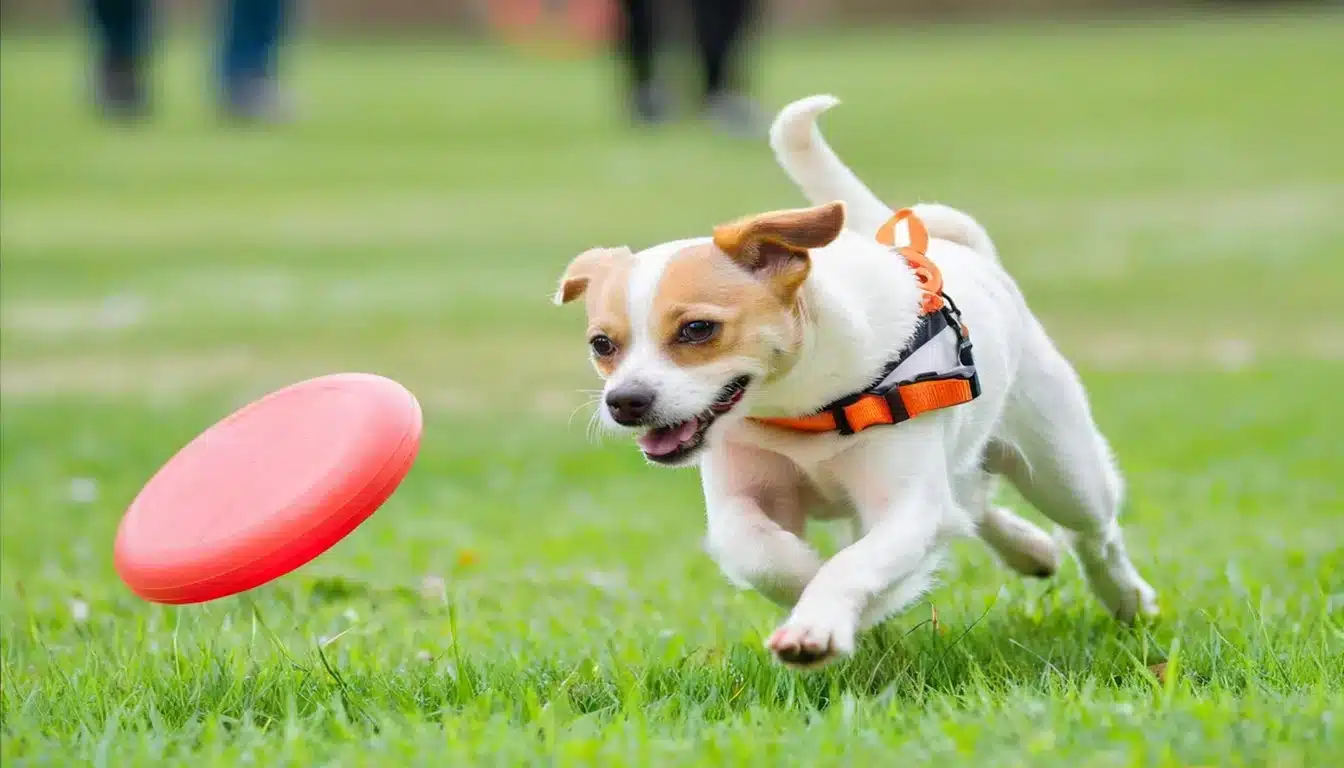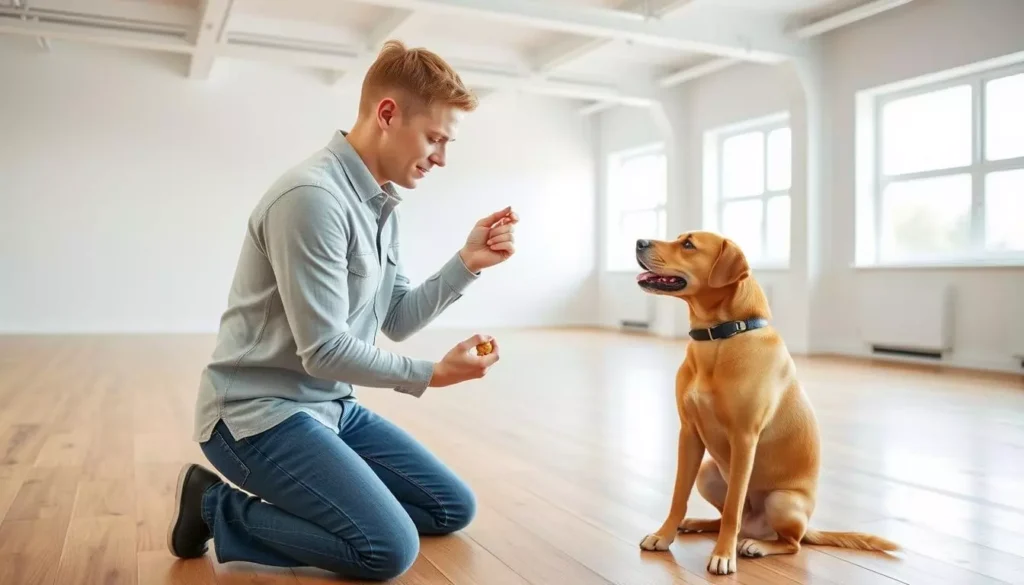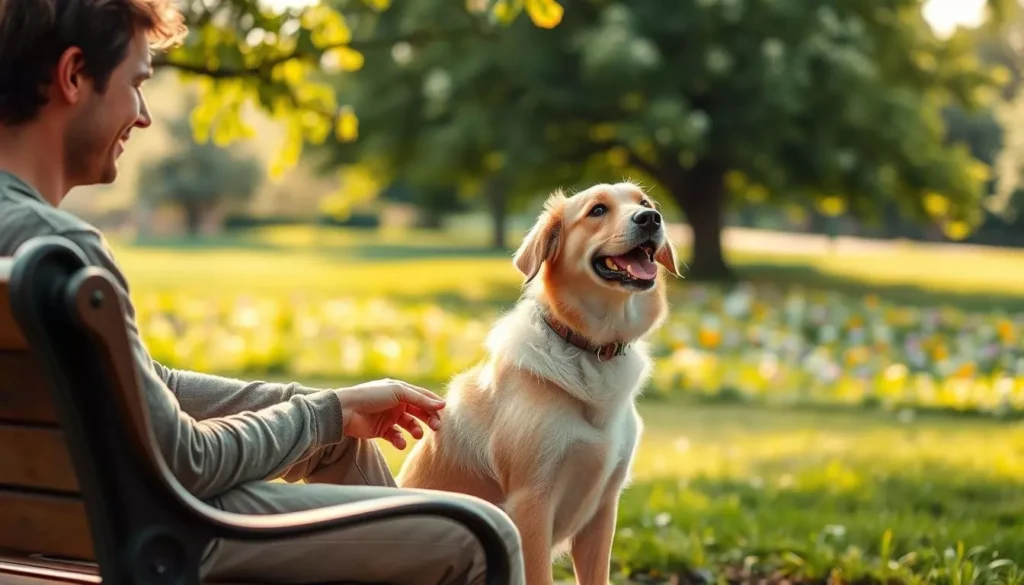I remember the first time I saw a dog catch a frisbee in mid-air. It was like magic – a beautiful dance between a human and a dog. This moment sparked my passion for dog training.
My Australian Shepherd, from the start, had a strong drive to chase and catch frisbees. Dog training is more than teaching tricks. It's about building a strong bond with your furry friend.
Frisbee training is a fun way to engage your dog's natural instincts. It provides mental and physical stimulation. In this guide, I'll share beginner and advanced techniques for teaching your dog to catch a frisbee.
Whether you dream of competitive disc dog performances or just backyard fun, this guide is for you. It will help you and your dog learn an amazing new skill. Get ready for extraordinary moments of connection and joy.
Key Takeaways
- Frisbee training strengthens the bond between dogs and owners
- Start training when your dog is young and energetic
- Choose the right type of frisbee for your dog's size and skill level
- Patience and consistent practice are crucial for success
- Safety should always be the top priority during training
- Positive reinforcement works best in dog training
Understanding the Basics of Frisbee Dog Training
Frisbee training is a fun journey into dog sports. It mixes obedience with play. As a dog trainer, I've found it builds a strong bond with your dog.
Success in frisbee training comes from positive reinforcement. Dogs love activities that challenge their minds and bodies. This makes frisbee perfect for active dogs.
Benefits of Frisbee Training for Dogs
Frisbee training has many benefits for dogs:
- Improves physical fitness and coordination
- Boosts mental stimulation and problem-solving
- Strengthens the bond between dog and owner
- Offers a way for high-energy breeds to play
Choosing the Right Age to Start Training
Timing is key in frisbee training. Puppies can start with basic games at 8-10 weeks old. But, full training should wait until they're physically ready.
Required Skills and Prerequisites
Before starting frisbee training, make sure your dog knows these basics:
- Basic obedience commands
- Reliable recall
- Strong retrieve instinct
- Good physical condition
Frisbee training is about having fun and showing off your dog's skills. With patience and positive reinforcement, you'll discover a new world of fun with your dog.
Selecting the Perfect Frisbee for Your Dog
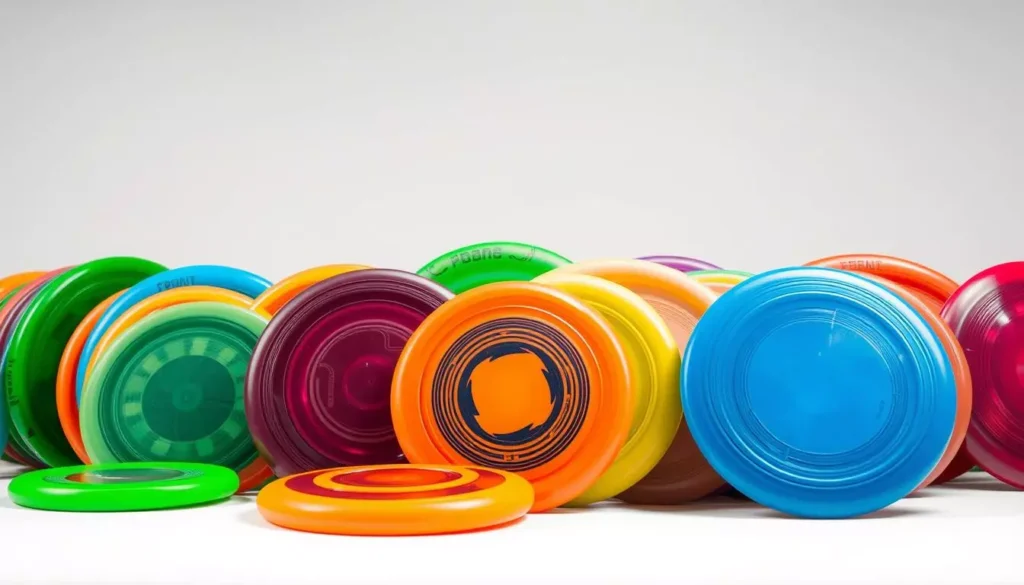
Choosing the right frisbee is key for your dog's success and fun in frisbee dog training. Not all frisbees are the same. The perfect one can greatly impact your training journey.
Start with different frisbees based on your dog's skill level. Soft discs are best for beginners. They are gentle and safe for your dog's mouth during training.
- Soft fabric discs: Perfect for puppies and new learners
- Rubber training discs: Durable and easy to grip
- Competition-grade hard plastic discs: Ideal for advanced dogs
Consider these important factors when picking a frisbee:
- Your dog's age and skill level
- Mouth size and comfort
- Durability of the disc material
- Weight and aerodynamics
Pro tip for disc dog training: Begin with brightly colored discs that are easy for your dog to follow. As your dog gets better, switch to more advanced equipment.
The right frisbee can change your training for the better. Spend time finding the perfect disc that fits your dog's abilities and love for training.
Building Initial Interest and Motivation
Getting your dog excited about frisbee training is key to success. Reward-based training makes frisbee play fun and engaging. As a professional dog trainer, I've found ways to make these activities more exciting and enjoyable for dogs.
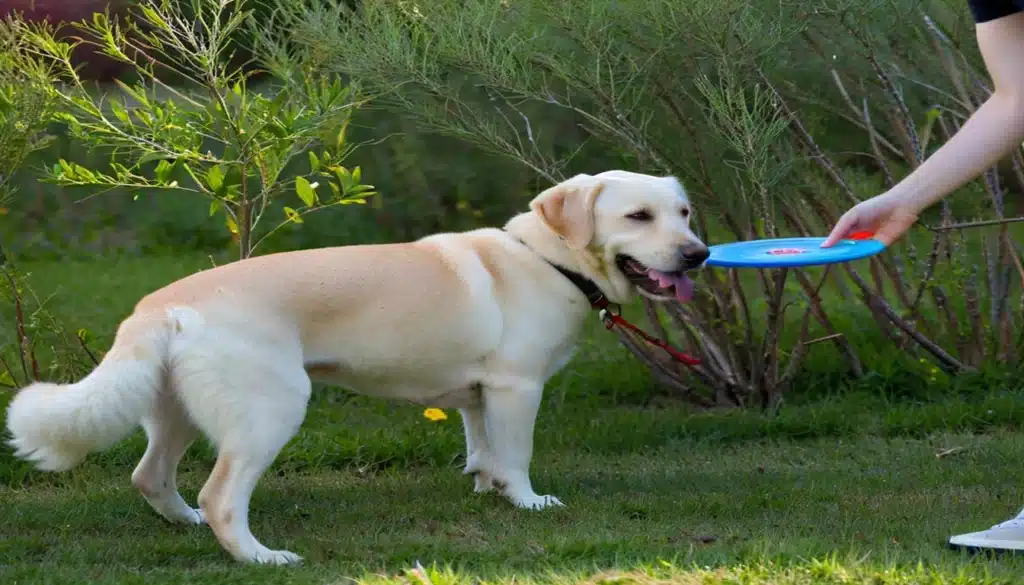
The secret to getting your dog's interest is to make the frisbee a positive thing. Dogs are naturally curious. With the right approach, you can turn this simple disc into a must-have toy.
Using Food and Treats with the Frisbee
Begin by making the frisbee a source of tasty rewards. Here are some effective techniques:
- Feed meals directly from the frisbee
- Hide treats underneath the disc
- Use high-value treats during initial interactions
- Praise your dog enthusiastically when they show interest
Creating Value Through Limited Access
Make the frisbee seem more special by limiting access. Store the frisbee out of reach and only bring it out for special training sessions. This makes the frisbee a rare and exciting treasure your dog will look forward to.
Incorporating Tug Games
Tug games are great for building your dog's drive and engagement. Professional trainers suggest using the frisbee as a tug toy. This creates excitement and develops a strong play drive. Start with short, controlled tug sessions that end on a positive note, reinforcing the fun of frisbee interactions.
The key is to make frisbee training feel like a game, not a chore.
How to Teach a Dog to Catch a Frisbee: Step-by-Step Guide
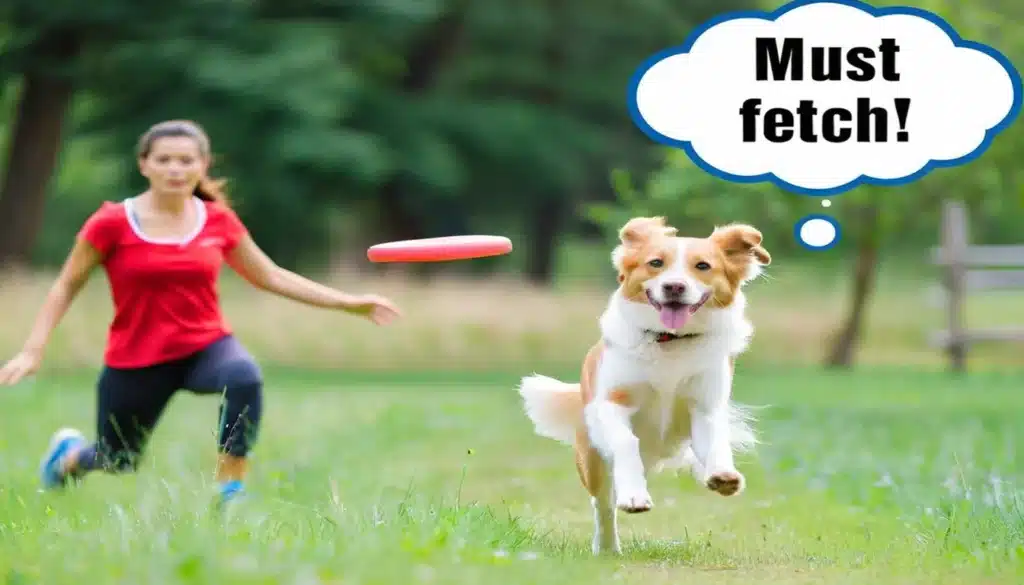
Teaching a dog to catch a frisbee needs patience and a smart plan. I'll show you a detailed guide to turn your dog into a frisbee-catching pro.
Begin with training on the ground to boost your dog's confidence and interest. Here's a method that works:
- Start with frisbee rollers to get your dog excited
- Move to short, low throws
- Practice bringing back the frisbee
- Give rewards for every good action
Make training fun and rewarding. Use soft, safe frisbees that won't hurt your dog's mouth.
"Training a dog to catch a frisbee is about building trust and creating a game both of you enjoy." - Professional Dog Trainer
When your dog gets more confident, throw the frisbee farther and higher. Look for signs like eager tracking and consistent returns. Every dog learns in their own way, so adjust your training to fit your dog's personality and skills.
- Use high-value treats to motivate
- Keep training sessions short and fun
- Practice in places without distractions
With regular practice and patience, your dog will catch frisbees like a pro!
Essential Training Games and Exercises
Turning dog training into an adventure needs creativity and fun games. Frisbee tricks become more fun with interactive exercises. These games build your dog's skills and excitement. Let's explore some engaging training games that make dog training both fun and effective.
The "Back and Forth" game is key for frisbee skills. Start by standing close to your dog and tossing the frisbee gently. Encourage your dog to bring it back, then throw it further. This game boosts:
- Tracking skills
- Retrieval confidence
- Hand-eye coordination
- Engagement with you
The "Target Practice" game is also great. Place markers at different spots and angles. Challenge your dog to catch the frisbee from these spots. This game improves:
- Spatial awareness
- Catching precision
- Overall agility
"The key to successful frisbee dog training is making every moment feel like play, not work." - Professional Dog Trainer
Always remember, training with frisbee tricks should be fun and safe for your dog. Keep sessions short, positive, and rewarding. Each game is a chance to grow closer and boost your dog's confidence in catching and returning the frisbee.
Proper Throwing Techniques for Dog Safety
Learning to throw a frisbee right is key for safe and fun dog sports. As someone who loves frisbee with dogs, I've found that the right way to throw keeps dogs safe and makes the game more fun.
Safe frisbee throwing means paying attention to a few important things. You want to make throws that are fun and easy for your dog to catch.
Low Line Drive Throws
Low line drive throws are the best for safe frisbee training with dogs. They help avoid hard landings and keep your dog safe. Here's how to do a low line drive:
- Keep the frisbee close to the ground
- Use a smooth, controlled throwing motion
- Aim for a flat trajectory
Height and Distance Control
Knowing your dog's skills is crucial in frisbee games. Different dogs can jump and catch in different ways. Here's what I suggest:
- Start with short, low throws
- Gradually increase distance as your dog improves
- Watch your dog's comfort and energy levels
Landing Zone Considerations
The surface where your dog lands is as important as the throw. Soft, even surfaces like grass are the safest for frisbee play. Stay away from hard surfaces like concrete or areas with obstacles that could hurt your dog.
Safety first: A well-executed throw is about protecting your dog while enjoying the excitement of the game.
Preventing Injuries During Frisbee Training
Dog training for frisbee needs careful attention to avoid injuries. As a seasoned trainer, I know keeping your dog safe is key. This is especially true for high-energy activities like catching frisbees.
Warm-up exercises are vital to get your dog's muscles ready. I suggest starting with a detailed pre-training routine. This should include:
- Gentle stretching movements
- Low-intensity walking
- Slow jogging in place
- Gradual muscle activation exercises
Vets and animal chiropractors recommend certain warm-ups to lower injury risks. Getting advice from a pro can help tailor your dog's training to their needs.
Don't forget about keeping your dog hydrated and giving them enough rest. Make sure they have fresh water and enough time to recover between sessions.
"A well-prepared dog is a safe dog" - Veterinary Sports Medicine Association
Watch your dog's energy levels and look for signs of tiredness. Gradually increase the intensity of training. These steps will make frisbee training safer and more fun for your dog.
Advanced Frisbee Techniques and Tricks
Once you've got the basics down, advanced frisbee tricks open up. These tricks can turn your dog's catches into amazing shows of skill.
Let's explore some top-level frisbee tricks for your dog. These moves need patience, practice, and a strong bond between you and your dog.
Teaching the Backstall
The backstall is a trick that wows the crowd. It shows off your dog's amazing coordination. Here's how to teach it:
- Start with low-height throws
- Use positive reinforcement
- Practice on soft surfaces
- Gradually increase difficulty
Developing Multiple Catch Sequences
Creating catch sequences that wow requires smart training. Focus on:
- Building directional control
- Enhancing spatial awareness
- Practicing rapid-fire throws
- Rewarding complex catch combinations
Competition-Style Moves
If you're into competitive frisbee, learn these moves:
- Freestyle jumps
- Mid-air interceptions
- Spinning catches
- Distance catches
Always put safety first. Move slowly and keep training fun and positive.
Conclusion
Reflecting on frisbee dog training, I see the magic of dogs and owners connecting through play. It's not just teaching a skill. It's about creating joy and a strong bond with your pet.
Fun activities like frisbee training do more than just exercise. They challenge your dog's mind and body. They also strengthen your bond. Patience and practice are crucial for success.
Every small victory is a celebration of your connection. Whether you're playing in the backyard or aiming for competitions, enjoy the journey. Each dog learns differently, so cherish your unique path.
The thrill of your dog catching a frisbee is priceless. It makes every training moment worth it. My advice is to start simple, keep it fun, and always put your dog's happiness first.
Frisbee training can turn any day into an adventure. It creates memories that last forever. So, grab a disc, go outside, and let the fun begin!

